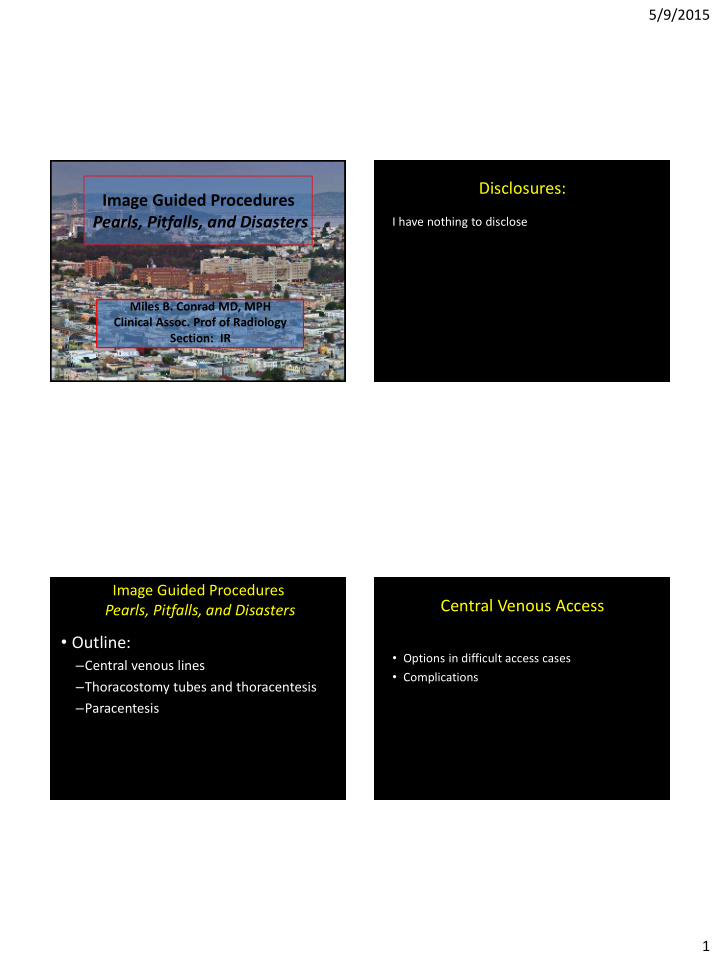



5/9/2015 Disclosures: Image Guided Procedures Pearls, Pitfalls, and Disasters I have nothing to disclose Miles B. Conrad MD, MPH Clinical Assoc. Prof of Radiology Section: IR Image Guided Procedures Central Venous Access Pearls, Pitfalls, and Disasters • Outline: • Options in difficult access cases – Central venous lines • Complications – Thoracostomy tubes and thoracentesis – Paracentesis 1
5/9/2015 Subclavian Access IJ Access Ultrasound is almost never used…but it works well!! • Standard IR practice Indications Contraindications – Seems to be safer than subclav for short term • Thrombosed /occluded IJ’s • Ax node dissections • Prior CV catheters • Fistulas access • IVDU • DVT – Long term subclavian access inc rates of subclav. • Neck infections • Long standing catheter need stenosis • Tracheostomy tubes – Very low chance of ptx in experienced hands • C collars *Crit Care Med. 2002 Feb;30(2):454-60 US Subclavian Access Infra clavicular Subclavian Access Infraclavicular view of the Subclavian V. and A V A 2
5/9/2015 Infra clavicular Subclavian Access Supra clavicular Subclavian Access When attempting this, needle tip localization is of paramount importance! Supra clavicular Subclavian Access Supra clavicular Subclavian Access Why? • If you can identify subclavian v. better than with infraclav view • Tiny subclavian v. • Thrombosed IJ’s Needle tip localization is key...or this is dangerous 3
5/9/2015 78 yo F w/ ESRD, failed upper extrem Supraclav subclav HD cath grafts, R pacemaker IJ’s are out Supraclavicular view of R subclav. V. Be aware of the warning signs of SVC Chest wall collaterals portend a syndrome… difficult access 4
5/9/2015 Catheter in azygous • The azygous will reverse flow and enlarge in infraazygous SVC occlusion Catheter in azygous – Very common in pts with chronic catheter pts and dialysis fistulas 5
5/9/2015 Complications • Dilator injuries • Malpositioned lines Kink, BC vein puncture • Air embolus • Arterial puncture • Ptx • Loss of wire • Infection Earlier CT Malpositioned line Catheter in Ao or L SVC? Dublicated SVC: 0.3-.5% 6
5/9/2015 Air Embolus Inadvertent Arterial Line RV Jumper s/p R subclav cordis placement Seen incidentally in up to 50% pts on CT and is usually of no significance This may be a morbid/lethal issue in cardiopulmonary dz or those with R-L shunts 7
5/9/2015 54 yo F s/p L chest wall resection R Vertebral artery Cordis tip R CCA These get filled with thrombus 8
5/9/2015 Pseudoaneurysm and Brachial a. Subclavian Covered Stent Embolus s/p attempted R IJ placement 9
5/9/2015 Presumed alveolar-pleural fistula w/ Lung re-expanded on LCWS air leak Likely tear injury to pleura Consider decreasing negative pressure 55 yo M w/ sepsis, s/p R IJ line until lung is up on waterseal RIJ cath still around line Wires are usually pushed in due to failure to hold the wire while advancing the dilator or catheter 10
5/9/2015 Loss of wire Wire retrieval from groin Alternate IV site: Deep Brachial/Basilic The solution for IV access in skin Puncture poppers . Median n. Brachial a. Basilic v. Brachial v. Traditional angiocaths are too short! 11
5/9/2015 Pleural Drainage Thoracostomy Tubes: • Thoracostomy tubes/Thoracentesis – Empyema – Efficacy of fibrinolysis of infected pleural effusions • tPA and DNAse • Bleeding associated with tPA – Transcostal access techniques • Complications – Malpositioned tubes – Bleeding Small bore (6-F to 16-F) Large bore (18-F to 28-F) Pigtail Catheter Thalquick Catheter Pleural fluid CT Underrepresents Septations Lung abscess: Avoid this! Likely will need fibrinolysis… 12
5/9/2015 MIST II Double Blind Trial % Δ in pleural opacity from Day 1 to 7 on CXR • 10 mg TPA alone • -17+/- 24.3 (p=0.55) • 5 mg DNAse alone • -14.7 +/- 16.3 (p= 0.14) • DNAse + TPA • -29.5 +/- 23.3 (p=0.005) • Saline alone • -17.2 +/- 19.6 • Bid tx x 3 days • Clamped x 1 hr SFGH experience: 5% of patients develop severe chest pain and some required NEJM 2011;365:518-26 elevated level of care 28 yo M s/p GSW to lung s/p wedge resection 53 yo F w/ ovarian CA w/ adjacent hematoma tPA = bad idea Massive Hemoptysis Intercostal artery injury and abdominal chest tube 13
5/9/2015 There are many arteries to contend Intercostal artery embo with Supracostal artery Moore E. STR 2004 Walking over a rib does not prevent all bleeding US guided chest tubes require 3 pt. 18 yo M s/p MCA confirmation to avoid abdomen 1. Visualize needle in fluid 2. Visualize wire in pleura 3. Visualize pigtail in fluid Wire Liver 14
5/9/2015 Posterior tube Tube is clogged Tube in fissure Tube Malposition: Spontaneous Ptx Delay in Resolution of Ptx Blind midaxillary line pigtails often often don’t go to the anterior apex 15
5/9/2015 Avoid This: Paracentesis • Complications: – Inadvertent puncture of vessel , organ, bowel – Infection: aseptic technique – Post Paracentesis Circulatory Dysfunction (PCD) Case courtesy of Vishal Kumar, MD… he did not do this Caput Medusa Abdominal wall varices 16
5/9/2015 Arterial Injury s/p Paracentesis 41 yo M w/ hypotension, 3 pressors, tachy s/p paracentesis, severe pulm HTN, codes if supine or < 45 degrees Heme Jet 17
5/9/2015 Conclusions • Lines: – Alternative line access sites only when very comfortable with seeing needle tip with US – Be weary of pts with long standing indwelling catheters or pacemakers…look for chest wall vessels • Pleural access Dynamic US method is probably safest • Paracentesis Vs. ? • Most complications are avoidable 18
Recommend
More recommend